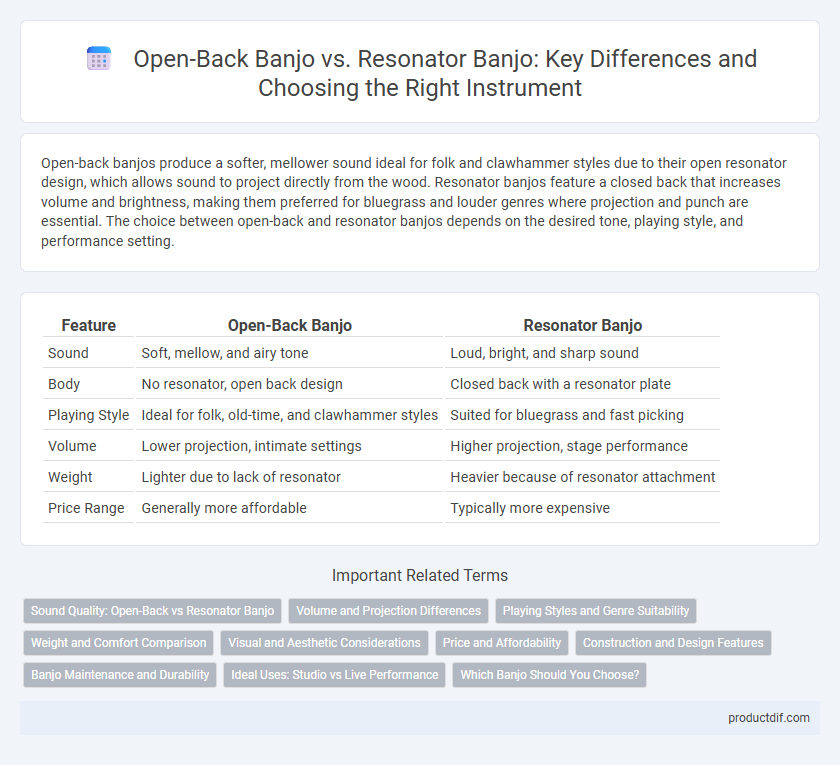Open-back banjos produce a softer, mellower sound ideal for folk and clawhammer styles due to their open resonator design, which allows sound to project directly from the wood. Resonator banjos feature a closed back that increases volume and brightness, making them preferred for bluegrass and louder genres where projection and punch are essential. The choice between open-back and resonator banjos depends on the desired tone, playing style, and performance setting.
Table of Comparison
| Feature | Open-Back Banjo | Resonator Banjo |
|---|---|---|
| Sound | Soft, mellow, and airy tone | Loud, bright, and sharp sound |
| Body | No resonator, open back design | Closed back with a resonator plate |
| Playing Style | Ideal for folk, old-time, and clawhammer styles | Suited for bluegrass and fast picking |
| Volume | Lower projection, intimate settings | Higher projection, stage performance |
| Weight | Lighter due to lack of resonator | Heavier because of resonator attachment |
| Price Range | Generally more affordable | Typically more expensive |
Sound Quality: Open-Back vs Resonator Banjo
Open-back banjos produce a warm, mellow sound with softer volume, ideal for traditional folk and old-time music. Resonator banjos feature a closed back with a metal or wooden resonator that amplifies sound, delivering brighter, louder, and more projecting tones suitable for bluegrass and professional performances. The distinct acoustic properties of each design significantly influence tonal clarity and volume, affecting player preference based on musical style.
Volume and Projection Differences
Open-back banjos typically produce a softer, mellower sound with less volume and projection, ideal for intimate settings or folk styles. Resonator banjos feature a solid back that projects sound forward, resulting in higher volume and sharper projection suitable for bluegrass and stage performances. The resonator design amplifies sound output by reflecting vibrations outward, making it more audibly prominent in ensemble contexts.
Playing Styles and Genre Suitability
Open-back banjos offer a softer, mellower tone ideal for folk, old-time, and clawhammer playing styles, emphasizing rhythmic strumming and melodic fingerpicking. Resonator banjos produce a louder, brighter sound suited for bluegrass and fast-paced picking techniques, often featuring fingerstyle and three-finger rolls. Players choose open-back for intimate, traditional settings and resonator models for energetic, stage-ready performances in genres like bluegrass and country.
Weight and Comfort Comparison
Open-back banjos are generally lighter, weighing around 5 to 6 pounds, making them more comfortable for extended playing sessions due to less strain on the shoulder and arm. Resonator banjos typically weigh between 7 and 9 pounds because of the additional wooden resonator attached to the back, which adds significant weight but enhances projection. Players seeking a lightweight instrument for comfort often prefer open-back models, especially for folk and clawhammer styles.
Visual and Aesthetic Considerations
Open-back banjos feature a hollow, exposed back that contributes to a vintage, rustic aesthetic favored in folk and old-time music circles, while resonator banjos have a closed back with a shiny, usually wooden resonator that offers a polished, modern appearance appreciated in bluegrass and stage performances. The visual design of resonator banjos often includes decorative inlays and glossy finishes that reflect light on stage, enhancing their presence under performance lighting. Open-back banjos present a more minimalist and traditional look, attracting players who prioritize authenticity and a classic, handcrafted vibe.
Price and Affordability
Open-back banjos typically offer a more affordable entry point, with prices often ranging from $150 to $600, making them ideal for beginners and casual players. Resonator banjos, featuring more complex construction and enhanced projection, generally start around $500 and can exceed $2,000, reflecting their professional-grade craftsmanship and sound quality. Budget-conscious buyers should weigh the cost difference against desired tone and playing style to determine the best value.
Construction and Design Features
Open-back banjos feature a hollow wood or metal back that allows sound to project freely, producing a softer, mellower tone ideal for folk and old-time music. Resonator banjos have a closed back with a wooden resonator plate that amplifies volume and brightness, making them popular in bluegrass genres. The resonator's added weight and design also enhance projection and sustain, while open-back models prioritize portability and comfort.
Banjo Maintenance and Durability
Open-back banjos require less frequent maintenance due to their simpler design, allowing easier access for cleaning and string replacements. Resonator banjos feature a protective backplate that enhances durability by shielding the instrument from physical damage and environmental factors. Choosing a resonator banjo often results in longer-lasting structural integrity, especially for players in active or outdoor settings.
Ideal Uses: Studio vs Live Performance
Open-back banjos deliver a softer, mellower tone ideal for studio recordings and folk or clawhammer styles where subtlety and nuance are paramount. Resonator banjos project a louder, more piercing sound suited for live bluegrass performances and outdoor settings, ensuring sound cuts through ambient noise. Choosing between them depends on whether the environment prioritizes controlled acoustics or maximum volume and projection.
Which Banjo Should You Choose?
Open-back banjos deliver a softer, mellower tone ideal for folk and old-time music, while resonator banjos produce a louder, brighter sound suited for bluegrass and performance settings. Consider your music style and playing environment; open-back models excel in intimate, acoustic settings, whereas resonator banjos project more volume for stage presence. Your choice depends on balancing tonal preference and desired sound projection for your specific musical needs.
Open-back banjo vs Resonator banjo Infographic

 productdif.com
productdif.com